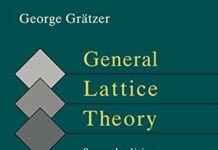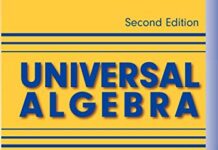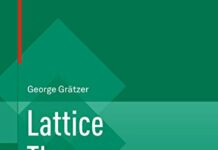
Ebook Info
- Published: 2014
- Number of pages: 298 pages
- Format: PDF
- File Size: 4.27 MB
- Authors: George Grätzer
Description
Practical LaTeX covers the material that is needed for everyday LaTeX documents. This accessible manual is friendly, easy to read, and is designed to be as portable as LaTeX itself.A short chapter, Mission Impossible, introduces LaTeX documents and presentations. Read these 30 pages; you then should be able to compose your own work in LaTeX. The remainder of the book delves deeper into the topics outlined in Mission Impossible while avoiding technical subjects. Chapters on presentations and illustrations are a highlight, as is the introduction of LaTeX on an iPad.Students, faculty, and professionals in the worlds of mathematics and technology will benefit greatly from this new, practical introduction to LaTeX. George Grätzer, author of More Math into LaTeX (now in its 4th edition) and First Steps in LaTeX, has been a LaTeX guru for over a quarter of century.From the reviews of More Math into LaTeX:“There are several LaTeX guides, but this one wins hands down for the elegance of its approach and breadth of coverage.”—Amazon.com, Best of 2000, Editors Choice“A very helpful and useful tool for all scientists and engineers.”—Review of Astronomical Tools“A novice reader will be able to learn the most essential features of LaTeX sufficient to begin typesetting papers within a few hours of time…An experienced TeX user, on the other hand, will find a systematic and detailed discussion of all LaTeX features, supporting software, and many other advanced technical issues.”—Reports on Mathematical Physics
User’s Reviews
Reviews from Amazon users which were colected at the time this book was published on the website:
⭐It’s a good book. But don’t buy the kindle version, which really screwed the book. Actually almost all kindle ebooks, which I’ve bought and involve math (formulas, square roots, integrals, etc), share the same problem. A reader should not be surprised that a weak book format that kindle uses has trouble in displaying the results of a powerful format/language like LaTeX.OTOH, I’ve typed and run almost every example in the book because I have to see what the results really are on my computer, not those in the kindle book. This is probably not a bad thing (ironically).
⭐What can I say? It’s Practical
⭐I’m still an amateur when it comes to LaTeX, curious to learn it but without an urgent need to use it, and lacking the patience to trek a hundred pages or more through software geeks’ often vain attempts at prose. Being too restless to work far into Stefan Kottwitz’s “Beginner’s Guide,” I was intrigued by the current book’s promise to teach you the basics in the first 30-page chapter, entitled “Mission Impossible.”The book is pretty clear as far as it goes, but it’s *very* focused on document creation for working mathematicians. E.g., you learn about formulas and tables in the first chapter – but not about how to make paragraphs (which comes up in Chapter 2). The only document class discussed is the American Mathematical Society articles (amsart) class; differences among document classes aren’t explained. Examples from other sciences, such as physics and engineering style vector notation, Feynman diagrams, gene maps, chemical reactions, chemical structures and EE and CE engineering schematics, are all absent, too. Kottwitz, on the other hand, foregrounds text formatting, with math formulas getting only a brief chapter near the end. So if in fact you do use lots of formulas (which after all is the main advantage of using LaTeX) this book by Grätzer is definitely the better one to start from. And even for prose-centric users like me the discussion is relatively smooth and direct, avoiding Kottwitz’s rigid and pedantic expository structure and his many digressions on the historical development of the software.One area for improvement, though: The text is filled with frequent “practical tips” and “practical rules,” but the criteria for these categories, esp. the latter, are rather unclear. While the “tips” usually do seem like practical tips, some “rules” seem like tips, some are phrased as concise rules, and some are fairly involved descriptions of, say, how LaTeX parses various character strings. The “rules” in this last category are too long to be “practical,” and/or not sufficiently qualitatively different from other text. An example is the “practical rule” for command termination @35: this describes how LaTeX works, not what the user should do. Another example: a “practical rule” for the subject classifications command in the amsart document class says “2010” is an optional argument, but a “practical tip” on the next page says that this is effectively a *compulsory* argument (@103-104) — which sounds more like a rule than a tip. Greater consistency in the tips/rules/regular text allocations would be a good goal for the 2nd edition.The book has a website where you can download samples mentioned in the text. The zip file seemed to lack a particular file, sample.sty, which the author mentions you should make sure to have when you typeset a sample document, though the samples typeset without problem for me anyway (I’m using the MacTEX-2012 distribution). If you plan to type in Romance languages, among others, the book takes it for granted that you know how to make “smart” or curly single quotes within a text editor; this wasn’t obvious to me, but a little trial and error took care of it (alt+[ and alt+{ on my Japanese Mac keyboard). For a next edition, an idiot-proof guide to downloading and installing new packages would be welcome. My holy grail of a LaTeX guide, one that could teach a total beginner how to create a long text document with multilingual text (e.g., English, French and Japanese), footnotes/endnotes/references, some simple formulas, and basic font and layout manipulations all within a 2-hour tutorial, has yet to be realized. (If I’m wrong about that, please let me know!) Nonetheless, this book should be very popular with math students, and can be a helpful supplement for non-mathematicians, too.
⭐As advertised
⭐Excellent book!
⭐I’ve read or browsed other LaTeX books published in the 1990’s but none are as good and practical as this Grätzer’s. And, it’s very helpful that it was published in the 21st century: LaTeX is an old system, with lots of cruft and different ways of doing things. Grätzer focuses on the best current way. This book is a gem and is light-years ahead of the competition.
⭐The book is well written and would be very suitable for persons wishing to use LaTex for mathematical purposes. It was written for them and I award it 4 stars on that basis. It would be unfair to down rate it because it is not what I wanted. In common with all of the books that I have read about LaTex, it assumes that its readership is composed of established users seeking to advance their skills. Unfortunately, I am at a much lower level.
⭐Indeed very practical.
⭐As a more or less novice I could not find any help in this book so I googled it all. I will still rate it with 3 stars as it may be fa good fit to a Latex pro.
⭐In short, I would say: It is concise and to the point.
Keywords
Free Download Practical LaTeX 2014th Edition in PDF format
Practical LaTeX 2014th Edition PDF Free Download
Download Practical LaTeX 2014th Edition 2014 PDF Free
Practical LaTeX 2014th Edition 2014 PDF Free Download
Download Practical LaTeX 2014th Edition PDF
Free Download Ebook Practical LaTeX 2014th Edition




